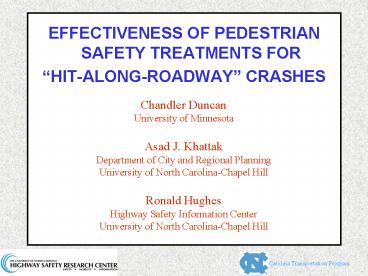EFFECTIVENESS OF PEDESTRIAN SAFETY TREATMENTS FOR - PowerPoint PPT Presentation
1 / 20
Title:
EFFECTIVENESS OF PEDESTRIAN SAFETY TREATMENTS FOR
Description:
with high levels of unemployment, older housing stock, more single parents, ... NC Wake County sites: Extensive data collection ... – PowerPoint PPT presentation
Number of Views:90
Avg rating:3.0/5.0
Title: EFFECTIVENESS OF PEDESTRIAN SAFETY TREATMENTS FOR
1
- EFFECTIVENESS OF PEDESTRIAN SAFETY TREATMENTS FOR
- HIT-ALONG-ROADWAY CRASHES
Chandler Duncan University of Minnesota Asad J.
Khattak Department of City and Regional
Planning University of North Carolina-Chapel
Hill Ronald Hughes Highway Safety Information
Center University of North Carolina-Chapel Hill
2
Goals
- Examine crashes where pedestrians were
hit-along-roadway segments - Identify appropriate countermeasure strategies
suggested by experts - Draw implications from analysis
- US DOT funded field project
- HSRC implementer and evaluator
3
WakeCounty
4
WakeCounty
5
Previous work literature
- Risk factors
- Higher speed limit, lack of wide grassy walkable
areas, sidewalk absence - Nbds. with high levels of unemployment, older
housing stock, more single parents, higher uses
of bus service for work commutes - Different types of exposure
- Little focus on hit-along-roadway crashes
- Paucity of detailed crash inventory data
- Few attempts to explore countermeasures
- Applying expert opinions on complex phenomena
6
Method
Objective Explore risk factors associated with
hit-along roadway crashes countermeasures
- Experimental Design data collection
- NC Wake County sites Extensive data collection
- Crash site (N47) 2 comparison sitesCompanion
Remote - Archived data Visit sites, take photos
ped/veh counts - Surveys for a diverse Delphi panel Two
iterations
- Concepts
- Crash non-crash sites Dangerous
not-dangerous? - Risk f(Roadway/env factors Driver/ped
vehicle) - Correctly identified sites
- Countermeasures Infrastructure-based
- Analysis
- Can experts distinguish between crash and
non-crash sites? - Use panel responses to identify risk factors
- Panels opinion about countermeasures
- Conclusions and recommendations
- Visible risks countermeasures where subjective
judgment objective outcomes agree? - Implications
7
Pictures for the Experts
8
Delphi
- Panel of five HSRC ped safety expertsselected
based experience and convenience - Backgrounds in Psych, Bio-stats, Plan Eng
- 1st Iteration. Comparing triplets in terms of
- Least safe, pinpoint the visible risk factor
- Give relative importance of each risk factor
- Recommend countermeasures to offset the risk
- 2nd Iteration.
- Re-examine each triplet traffic and ped vol
- Information about others judgments
- Re-evaluate
9
Expert Survey 1
Safest A
Risks at safest
Risks at least safe
Countermeasures
10
Expert Survey 2
Volumes
Iteration 1 results Change in rankings
Importance of risk factors
Countermeasures
11
TheoryRoad/env factors Driver/Ped, Vehicle
12
Results Crashes opinions
13
Risks
Crash identified coefficient of times when
risk X was mentioned, the site was crash site
(0-to-1) Risk importance Rating given to risk
X (0-to-1)
14
What are the perceived risk factors?
- Discontinuous sidewalks
- Ambiguity about where peds should walk
- No unpaved walkable space
- No curb
- Road construction
- Cross traffic
- High vehicular volume
- Presence of large trucks
15
What are the countermeasures recommended by the
panel?
- Specific countermeasures sensitive to what seemed
'most appropriate' or 'likely to be installed'
given urban or rural nature of env. - Widen unpaved shoulder
- Construct pathway/walkway
- Install a sidewalk
- Install street lighting
- Effective lateral separation between motorized
non-motorized traffic
16
Matching risks countermeasures
17
Limitations
- Contribution of driver/ped vehicle factors not
investigated, e.g., - Drunk driver/ped
- Large truck
- Obtaining additional field data difficult
- Nighttime crashes
- Neighborhoods
18
Conclusions
- Pinpointing key risk factors countermeasures
- Lateral separation (sidewalk paved shoulders)
encouraged - May not be a universal measurescost
- Where are they needed?
- High-risk locations identified
19
Implications
- Experts limitations in pointing risks
- Infrastructure/env hazards may not always be
obvious - Delphi method to arrive at consensus on risks
and countermeasures - Valuable method
20
Future Steps
- Explore methods that can enhance lateral
separation of vehicles and peds - Travel lane boundary reflectors
- Rumble strips































